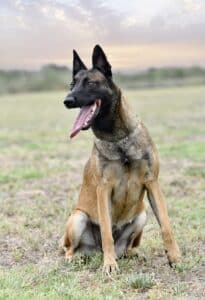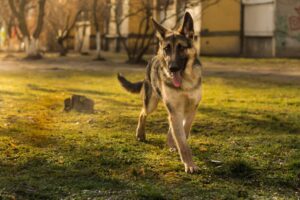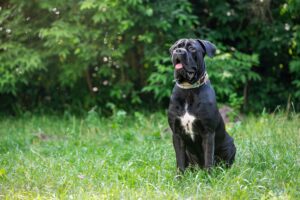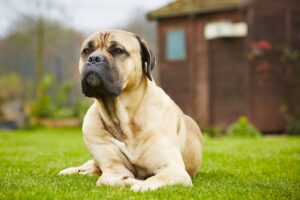






The Shepherds, Boxers, Rottweilers, Bullmastiffs, Dobermans, Cane Corsos, American Bulldogs, Black Russian Terriers… the list goes on.
Spend even a moment in their presence, and you’ll feel it: an ancient stillness. A protective instinct that has nothing to prove, yet everything to offer. Something deeper than bloodlines and beyond bark counts.
See, protection isn’t always wrapped in ferocity. It doesn’t always bare teeth or bristle its coat. In fact, the most devoted protection dogs don’t need to be aggressive to earn respect.
And that’s what we’re after, isn’t it?
A dog that protects your home, your family.… without ever tipping into violence that feels unwarranted. A dog that isn’t a liability in the park or at the vet. A dog that knows when to stand still. And when to stand tall.
So we ask the question:
What dog breed is protective… but not aggressive?
Let’s walk slowly to this answer.
 Before we get into the breeds, we need to talk about this line we keep drawing. Protective dogs aren’t inherently aggressive, though many people still confuse the two.
Before we get into the breeds, we need to talk about this line we keep drawing. Protective dogs aren’t inherently aggressive, though many people still confuse the two.
Protection is presence. It’s awareness, readiness, and loyalty. A sense of responsibility that doesn’t come from fear, but from a quiet confidence
Aggression? That’s about volatility. A lack of control. Reactivity without reason. It’s a dog that cannot self-regulate, that spins into conflict before clarity even arrives.
Let’s rethink our approach.
Most protection dogs were bred for work—herding, guarding, and hunting. They were shaped by generations of selection for very specific traits: courage, resilience, discernment, loyalty, and intelligence.
That’s the natural protective instinct. Not a desire to harm, but a drive to protect. To stay close. To be useful. To matter.
And it often is.
Down the years, some of these dogs have been genetically tampered with by backyard breeders chasing size or aggression rather than stability.
They wanted something dangerous, something that could puff its chest and cause unease.
And they got it at the cost of the right temperament (balance, mental clarity, and thoughtful restraint).
Other people have failed in different ways. Some dogs are left untrained and tossed into homes with no structure, socialization, or sense of direction.
Some dogs are bought as status symbols, only to be chained and ignored. Some are punished for natural behaviors—and then ignored when they start to spiral. Some are never taught what “good” looks like.
And slowly, they turn. Not because they were born bad. But because no one helped them become better.
So, when a dog lunges at the mailman or snaps at your dinner guests, it’s easy to blame the breed.
Yet, we should be looking at the blueprint. What was the dog built for? What shaped it? Who raised it? Who trained it? And more importantly—how?
This is why, when you’re searching for a dog that’s protective but not aggressive, I urge you: Get guidance.
Find someone who knows the breed but isn’t beholden to a breeder or a certain trainer. Someone who can see clearly, not through the lens of commission or kennel pride. There are exceptional breeders and trainers—ethical, intentional, and heart-led.
But some care more about volume than quality. And it’s not always easy to tell the difference at first glance. Be especially cautious with popular, overbred, and in-high-demand lines.
So… Which Breeds Fit the Bill?
It’s tempting to rattle off names again. Give you a list. Something practical. Something sharp-edged and definitive.
But instead, let me offer you a rhythm.
Here’s how you’ll know the right breed for you:
Now, if we had to name names (and we will), here are a few you might want to consider.
But remember—breed is the beginning, not the whole story.
Yes, we circled back……..

And yes, they can be aggressive if poorly trained, overbred, or raised in fear.
But a well-bred, well-socialized German Shepherd? That’s one of the most balanced guardians you can ask for.
They’re thinkers. Observers. Problem-solvers.
They don’t attack unless provoked, and they respond more to body language than loud commands. They know when to show force—and when to simply show up.
Their presence alone is usually enough.
But remember: Shepherds require structure. Daily engagement. A calm, confident leader. If you’re up for that, they’ll follow you anywhere.

They’ve got the muscle, the stance, and the “I’m ready if you are” posture. But inside? It’s a golden retriever in disguise.
Boxers are goofy. Playful. Deeply attached to their humans. And yet—they will put themselves between you and danger without hesitation.
They’re emotionally intelligent, incredibly attuned, and best of all, they don’t have a mean bone in their body unless something warrants it.
Many people misunderstand Rottweilers, but those who know them well adore them. Rotties are among the most balanced protection dogs.
Yes, they can be intimidating. But what makes a Rottweiler protective isn’t their bite. It’s their stillness. They possess an uncanny ability to read the energy in a room and determine what is worth responding to.
They’re family dogs at heart. They bond hard and deep.

This is a serious breed with a serious presence, but the aggression myth? That’s usually the result of poor breeding or poor handling.
In the right environment, with strong leadership and clear boundaries, the Cane Corso becomes a fortress with a heartbeat.
They’re deeply bonded to their family, suspicious of outsiders (but not reckless), and they’ve got the size and jaw strength to stop anything cold—if they have to.
The Malinois is always on.
That can be a gift or a challenge depending on the home they land in.
These are working dogs, born to serve, problem-solve, and move. Their minds are constantly active, constantly seeking the next task to monitor, comprehend, or resolve.
A well-adjusted Malinois isn’t aggressive. They’re responsive. They act on command, not impulse. They don’t escalate unless the situation truly calls for it.
They’re not for everyone, though. But for those who give them structure, purpose, and leadership, the Malinois gives back something sacred: loyalty

The Bullmastiff was bred to stand guard. That presence alone? Often enough. But don’t mistake calm for passive. These dogs are deeply territorial and fiercely loyal to their home and people.
Still, it’s not their size or strength that sets them apart. It’s their temperament. They’re patient, deliberate, and often described as “silent watchers.”
They don’t bite unless there’s no other option. Their philosophy is simple: de-escalate, deter, defuse. And if all else fails? Yes, they’ll act. But it won’t be out of rage. It will be out of responsibility.
That’s not aggression. That’s control.

They’re deeply intuitive. They watch, they wait, and they measure. And when the time comes to step forward, they do so with elegance and control, not brute force.
But Dobermans are not plug-and-play.
They need leadership that’s calm and consistent. They need work to do, and they need to be trusted. Micro-manage them or lead with fear, and you’ll break the very thing that makes them special.
None of this works without training.
Not the bloodline. Not the temperament. Not the best intentions. Even the gentlest protection breeds can become reactive, unstable, or dangerously unpredictable if they’re neglected, mishandled, or bred irresponsibly.
Instinct alone isn’t enough. You have to shape it, channel it, and refine it.
And that’s where training comes in—not just as a process, but as a partnership. Now, protection dog training isn’t a single course or a one-size-fits-all certification. It’s a progression. A layering of discipline, instinct, emotional intelligence, and adaptability.
And at the highest level? It’s art.
Here’s how it breaks down:
The foundation. Sit, stay, recall, heel. But more importantly—focus, impulse control, and responsiveness under different environments, unfamiliar people, or high-stress scenarios.
Without this, nothing else matters.
This is about awareness, not aggression. The dog learns to recognize threats and alert you—without acting unless instructed. Presence, posture, and vocal cues matter here.
And they’re trained to maintain the right level of alertness in every environment—whether they’re in your living room, at a crowded park, or walking beside you downtown.
Protection Training
This level includes subcategories based on the role the dog will play in your life:
This is a dog trained for high-stakes work—private security, executive protection, law enforcement, military detail. Environments where hesitation can cost lives, and aggression without restraint is just as dangerous.
What’s wild is that the best dogs at this level aren’t brutes—they’re thinkers. They don’t just react. They assess. They respond only when told, and when they do, it’s clean, fast, and efficient.
At this level, training molds itself around your life: tactical response in close-quarters environments or smooth integration with professional security teams.
You start to notice the subtleties. The way your dog mirrors your rhythm. How they move when you move and pause when you pause. It’s instinctual—but built on hours of practice. Trust becomes less about commands and more about intuition.
If you’re looking for a protective but not aggressive dog—there isn’t a single right breed. There are only the right fits.
It might be a German Shepherd. A Bullmastiff. A Boxer. A Doberman. Or maybe it’s a lesser-known gem—like the Giant Schnauzer or Great Pyrenees—quietly holding space, watching your world, ready when needed.
So when people ask me, “What breed should I get?” I ask them to back up. Start with your security needs. Then look at your lifestyle.
A family in the suburbs doesn’t need what a CEO with high-risk exposure might. A night-shift security guard has different requirements than a handler in a tactical unit. And not every home needs the intensity of a dog trained for combat-level work.
Figure out what you need. Then find the dog who can meet you there—without losing their balance or their mind.
Now….
How could we wrap this up without pointing you to where to get the right protection dog breed?
At Vanguard Protection Dogs, we don’t offer one-size-fits-all solutions. We believe in intentional matches specifically to YOUR situation, YOUR family, YOUR values, and YOUR protection needs.
Every dog in our program is hand-selected, professionally trained, and placed with purpose.
Book your private consultation today—and discover what it means to own a protection dog defined by presence, precision, and pedigree—not aggression.